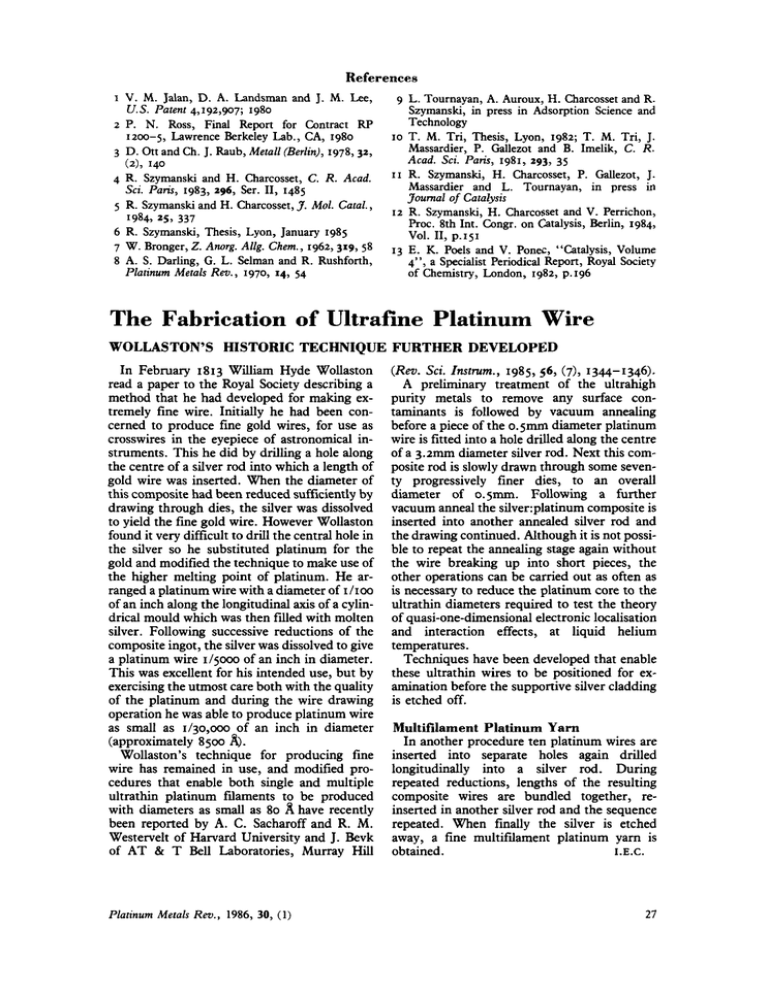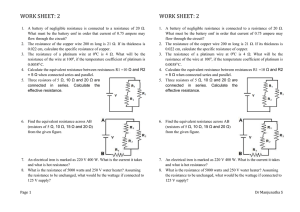The Fabrication of Ultrafine Platinum Wire
advertisement

I References V. M. Jalan, D. A. Landsman and J. M. Lee, 9 L.Tournayan, A. Auroux, H. Charcosset and R. U.S. Patent 4,19z,go7;1980 z P. N. Ross, Final Report for Contract RP 1200-5, Lawrence Berkeley Lab., CA, 1980 3 D. Ott and Ch. J. Raub, Metal1 (Berlin), 1978,32, (2),140 4 R. Szymanski and H. Charcosset, C. R . Acad. Sci. Paris, 1983,296, Ser. 11, 1485 5 R.Szymanski and H. Charcosset, 3. Mol. Catal., 1984, 253 337 6 R. Szymanski, Thesis, Lyon, January 1985 7 W. Bronger, Z. Anorg. Allg. Ckem., 1962,319,58 8 A. S. Darling, G . L. Selman and R. Rushforth, Platinum Metals Rev., 1970,14, 54 Szymanski, in press in Adsorption Science and Technology 10 T. M. Tri, Thesis, Lyon, 1982;T. M. Tri, J. Massardier, P. Gallezot and B. Imelik, C. R. Acad. Sci. Paris, 1981,293, 35 1 1 R. Szymanski, H. Charcosset, P. Gallezot, J. Massardier and L. Tournayan, in press in Yournal of Catalysis 12 R. Szymanski, H.Charcosset and V. Perrichon, Proc. 8th Int. Congr. on Catalysis, Berlin, 1984, Vol. 11, p.151 13 E. K. Poels and V. Ponec, “Catalysis, Volume 4”, a Specialist Periodical Report, Royal Society of Chemistry, London, 1982,p.196 The Fabrication of Ultrafine Platinum Wire WOLLASTON’S HISTORIC TECHNIQUE FURTHER DEVELOPED In February 1813 William Hyde Wollaston read a paper to the Royal Society describing a method that he had developed for making extremely fine wire. Initially he had been concerned to produce fine gold wires, for use as crosswires in the eyepiece of astronomical instruments. This he did by drilling a hole along the centre of a silver rod into which a length of gold wire was inserted. When the diameter of this composite had been reduced sufficiently by drawing through dies, the silver was dissolved to yield the fine gold wire. However Wollaston found it very difficult to drill the central hole in the silver so he substituted platinum for the gold and modified the technique to make use of the higher melting point of platinum. He arranged a platinum wire with a diameter of r / r o o of an inch along the longitudinal axis of a cylindrical mould which was then filled with molten silver. Following successive reductions of the composite ingot, the silver was dissolved to give a platinum wire 1/5000 of an inch in diameter. This was excellent for his intended use, but by exercising the utmost care both with the quality of the platinum and during the wire drawing operation he was able to produce platinum wire as small as 1/30,000 of an inch in diameter (approximately 8500 Wollaston’s technique for producing fine wire has remained in use, and modified procedures that enable both single and multiple ultrathin platinum filaments to be produced with diameters as small as 80 have recently been reported by A. C. Sacharoff and R. M. Westervelt of Harvard University and J. Bevk of A T & T Bell Laboratories, Murray Hill a). a Platinum Metals Rev., 1986, 30, (1) (Rev. Sci. Instrum., 1985, 56, (7), 134-1346), A preliminary treatment of the ultrahigh purity metals to remove any surface contaminants is followed by vacuum annealing diameter platinum before a piece of the 0.5wire is fitted into a hole drilled along the centre of a 3.2mm diameter silver rod. Next this composite rod is slowly drawn through some seventy progressively finer dies, to an overall diameter of o.smm. Following a further vacuum anneal the silver:platinum composite is inserted into another annealed silver rod and the drawing continued. Although it is not possible to repeat the annealing stage again without the wire breaking up into short pieces, the other operations can be carried out as often as is necessary to reduce the platinum core to the ultrathin diameters required to test the theory of quasi-one-dimensional electronic localisation and interaction effects, at liquid helium temperatures. Techniques have been developed that enable these ultrathin wires to be positioned for examination before the supportive silver cladding is etched off. Multifilament Platinum Yarn In another procedure ten platinum wires are inserted into separate holes again drilled longitudinally into a silver rod. During repeated reductions, lengths of the resulting composite wires are bundled together, reinserted in another silver rod and the sequence repeated. When finally the silver is etched away, a fine multifilament platinum yarn is obtained. I.E.C. 27


